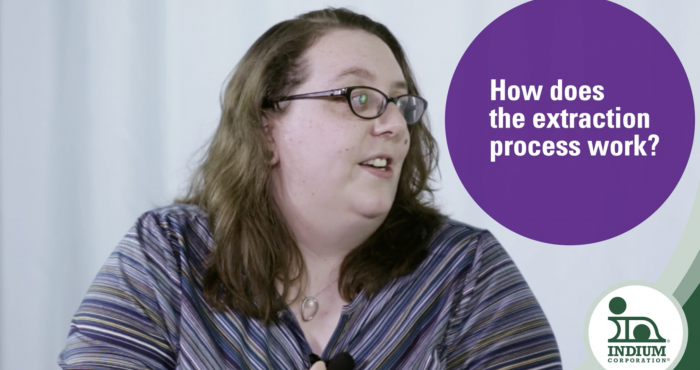Phil Zarrow: Brook, we know that in our industry there has never really been a do-all panacea cleanliness test. And on top of that, the one test we've relied on as a default standard, has been the Resistivity of Solvent Extract, ROSE test and that's being thrown out with the dishwater, so to speak, it's obsolete. So what direction are we going? What are we looking at as more finite?
Brook Sandy-Smith: Yeah, there isn't one test method.
Phil Zarrow: Right.
Brook Sandy-Smith: That's emerging as the winner, but there are a couple different test methods that have different reasons to choose them in, let's say three different categories of this test. So the first category is, how do you extract your ionic residues?
Phil Zarrow: Right.
Brook Sandy-Smith: That's a critical part. Then, do you test the resistivity of that solvent extract? Similar to ROSE, but is there a different way to do it, or a different limit to set, so that test is meaningful?
Phil Zarrow: Right.
Brook Sandy-Smith: And then thirdly, you could take that extract and run IC, ion chromatography, on it. So if you're going to do that, what would the limits for that be? So there are three different factors that we have to consider. With the extraction part, do we use localized extraction?
Phil Zarrow: Right, yes, or-
Brook Sandy-Smith: Do we use just water to extract? Which would only pick up polar species? Whereas, if you use a mixture of water and isopropyl alcohol, then you dissolve non-polar species as well. So how does the extraction process work? And how do we make that process the best to extract under low standoff components, or difficult to clean areas?
Phil Zarrow: Right.
Brook Sandy-Smith: How do we use those different methods to make the tests more accurate and better for high density assemblies, going forward?
Phil Zarrow: Right. So, the extraction methodology is yet to be determined. So this state of flux, pun intended ...
Brook Sandy-Smith: Yes.
Phil Zarrow: Bad pun, I know. But anyway, however, one of the things that's definitely emerging as another test that will be almost certainly standardized is Surface Insulation Resistance.
Brook Sandy-Smith: Well, Surface Insulation, SIR testing is definitely standardized. There are two different versions of this. There's the comb pattern, the B-24 test pattern, through IPC, which is used to classify materials in a standardized way. And then, for process control and process development, there's the B-52 test board, and a whole different test method, so that you can align the SIR testing with the components and the process that you're using to process the boards. That's the best way to test the reliability of the process and the material matrix that you've chosen.
Phil Zarrow: Okay, but one of the limitations of SIR testing is the fact that you do require the aforementioned SIR combs, so we're talking about building it into the circuit board, so we're essentially talking about testing at the prototype level, and qualifying the process.
Brook Sandy-Smith: Yes.
Phil Zarrow: So we would look at that for qualifying the process, and that looks like it's definitely on the track for being fairly standardized. And then looking at these other methodologies that you mentioned, with extracted methodologies for ongoing process measurement.
Brook Sandy-Smith: Right, so how do you capture the reliability that you've proven on your golden assembly, or in your process development phase? How do you correlate that to process control tests that you can make sure you keep those good trends going, through all of the time that you're processing this assembly?
Phil Zarrow: Very good. Well, this is outstanding because we've been relying on a test that was not very scientific, it was very empirical for what, almost 60, 70 years now. So I would say-
Brook Sandy-Smith: People love that test.
Phil Zarrow: I know.
Brook Sandy-Smith: People love putting a board into their little Ionograph meter, and getting a pass all the time.
Phil Zarrow: Right.
Brook Sandy-Smith: It makes them feel really good. They're doing a good job.
Phil Zarrow: Yes.
Brook Sandy-Smith: You cleaned it, you made a reliable assembly, great job. But if you scoop up some solder paste on your glove, and you stick it into the corner of the meter, and you don't measure any change in resistivity, you're just giving yourself a pat on the back.
Phil Zarrow: That's right.
Brook Sandy-Smith: You're not doing your due diligence to test what you're making, to make sure that it's reliable for a long time in the future.
Phil Zarrow: So, we're moving finally beyond methods of self-fulfillment, and really getting to actually scientific methodology for cleanliness testing.
Brook Sandy-Smith: Yeah, and it's necessary for the high voltage requirements, for RF, for high density assemblies. And moving forward, as we get more and more complex, these test methods for validation are going to be that much more critical.
Phil Zarrow: Brook, this is excellent. Where can we find out more information?
Brook Sandy-Smith: Well, we have a few other videos in this Electrochemical Migration series, so please check those out for more detailed information. There are also papers I've written on this topic, which you can find on www.indium.com. Or if you have questions, you can just contact me directly, at bsandy@indium.com.
Phil Zarrow: Brook, thank you so much.


